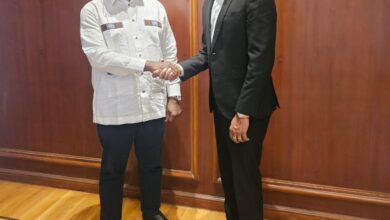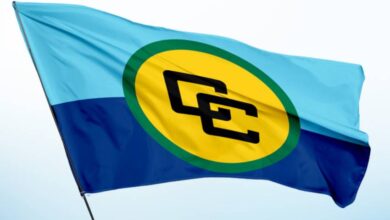It is my pleasure to bring you greetings from the Caribbean Community Secretariat and indeed the entire Caribbean Community on the occasion of this Fifteenth Meeting of the RCM
This RCM Meeting is particularly important as PANCAP prepares to celebrate its 10th anniversary at the annual General meeting in October/November this year. Ten years signify an important landmark in the life of any organization. This is particularly so in the case of PANCAP whose structure and organization and ipersistence as a Pan Caribbean Partnership, with one regional strategic framework, one coordinating mechanism and one resource mobilization plan is a unique model. Indeed it is deservedly referred to as an international best practice. At the same time, PANCAP embodies the principles of functional cooperation in the accelerated approach to HIV and AIDS. In so doing, it demonstrates the true meaning of the Needham’s Point Declaration at the 28th Conference of CARICOM Heads of Government in Barbados, in July 2008, of functional cooperation as a community for all.
The scope of this Partnership is all embracing. Every component of the Pan Caribbean — representatives of countries, governments, civil society, private sector, people lwith HIV and AIDS (PWA), youth, vulnerable groups across the linguistic zones and development partners – is included. It is a reflection of the nature and scope of the disease that knows no bounds, that requires a multi-sectoral approach and must be guided by creative and dedicated leadership.
In a gathering such as this one, there is no need for me to detain you with an elaboration of any of these attributes.
After all, the RCM is the lynchpin of PANCAP. It is vested with the responsibility to provide executive management of PANCAP’s business, to review its programmes, to evaluate and give guidance to the strengthening of relations between, and among, the Partners and to ensure that the Partnership is achieving its objectives.
As the Partnership plans for the celebration of PANCAP at Ten, it must at the same time look ahead and put in place a sustainability plan for PANCAP at 20. In so doing, the structures to strengthen the implementation of the Caribbean Regional Strategic Framework (2008-2013), the development of a PANCAP constitution and the efforts at sustaining the viability of critical core partners such as CRN+ and CCNAPC are commendable features of this transition. I am glad that these are specific items on the agenda of this meeting. But there are others also to which attention must be given as we look to the future.
First and foremost, there is need to recognize that the environment for resource mobilization has been significantly altered over the years including the changing conditionalities of the Global Fund, PEPFAR , the World Bank, and other major contributors to HIV and AIDS Programmes. At the same time, other major contributors to the initial Caribbean Strategic Framework (2002-2007) l such as the EU, DFID and CIDA are no longer on the HIV scene . Also, some foundation partners like PAHO, USAID , UNAIDS, together with CDC and GTZ among others, continue to invest in PANCAP as it charts a future of rapid changes in the configuration of funding challenges.
Second, it seems to me that the RCM has as its foremost task the establishment of those guidelines that would assist PANCAP (meaning all its stakeholders) to conquer the current challenges and those that lie ahead: challenges that could threaten the survival of the Partnership. In this regard, emphasis on the harmonization of resources must begin within the Partnership – how to rationalize resources, how to avoid duplication, how to ensure that partners assume obligations for contributing to the Partnership rather than just perceiving only its benefits. These are some of the moral values that must be imbued in the PANCAP of the future.
Third and somewhat related to the second, is the need for PANCAP, having established its own practices of harmonization, to demand the same from its development partners. This objective has been articulated persistently over the past ten years with minimum success. Some development partners are most willing to take the step; others are resistant for several reasons. This, however, is one envelope that the RCM must push and, in so doing, seek support at the highest level to ascertain that harmonization of donor resources is realized. The benefits will no doubt be mutual.
Fourth, the RCM must continue to advocate and articulate the region’s position, that the current posture of the international donors to marginalize most Caribbean countries from receipt of funding for HIV on the grounds of the middle income status is unjust and unjusified. We have to continue to make the case for its repudiation
Fifth, the Caribbean Community that is also undergoing its own process of reform and, indeed the Caribbean Community Secretariat in which the PANCAP Coordinating Unit PCU is located, will continue to provide all the necessary support to PANCAP. The role of the Council of Human and Social Development as a steadfast supporter of PANCAP remains undiminished. This is illustrated by the continued presence of its rotating Chair as a Chair of the RCM, and at the Community level, the longstanding chairmanship of PANCAP by Dr the Hon Denzil Douglas who has lead responsibility for Human Resource, Health and HIV.
Sixth, the planning for the 10th anniversary of PANCAP comes at a time when the full meaning of the Nassau Declaration: the Health of the Region is the Wealth of the Region (2001) is unfolding. PANCAP you would recall, is one pillar for the implementation of the actionable recommendations of the Declaration. The Caribbean Cooperation in Health (CCH) is the other. As an extension of CCH, the Caribbean Community Heads of Government has recently endorsed the establishment of the Caribbean Public Health Agency, a consolidation of five previously separately run regional health institutions into one public health agency. The convergence of these two pillars of the Nassau Declaration with similar trajectories of health systems strengthening, harmonization, rationalization , coordinated resource mobilization and sustainability planning, may yet provide the ultimate management challenge for the RCM in charting the road ahead for PANCAP.
These are my thoughts that I share with you. Hopefully you will find them useful as you plan for the landmark achievement of PANCAP at 10.
I wish to end with my warmest congratulation to Mr Carl Browne, Director of the PCU for his leadership, and appreciation to the staff of the PCU both, current and members, in particular Ms Cynthia Eledu, the first coordinator of the PCU and Mr. Edward Emmanuel Project Manager, who has just demitted office, and most of all Dr James St Catherine “my partner in crime” in those days of the Nassau Declaration when we could only dream that this day must come. But in the dream there is one sprit that looms large in our presence today i.e. Dr Barry Wint, a tireless gentle warrior on whose legacy we have the honour to build the future of PANCAP.
Madam Chair, Hon Ann Peters, and Deputy Chair, esteemed Professor Peter Figueroa, the future of PANCAP is in your hands as you guide the deliberations of this Fifteenth RCM meeting. Best wishes to you both and best wishes to you all.





